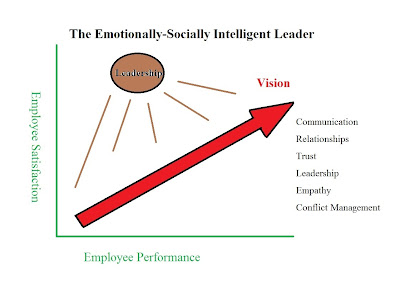Researchers have
explored different genres of leadership success for some time. They have come
to some interesting conclusions of what makes one leader more successful over
another. Intelligence, cognitive flexibility, and skill have provided only
partial explanations. Research by Singh (2013) further lends credibility that
leaders with high emotional and social intelligence are capable of influencing organizations
to achieve objectives at a level
Leadership can be seen
as a social skill which encourages strong followership. It is associated with
emotional intelligence factors such as attitude, confidence, respect, and
trustworthiness (Fehd, 2001). Through
positive actions, leaders foster the success of others and encourage beneficial
human-to-human relationships. They have the ability to disarm negativity and
work toward stronger goal achievement.
Leaders work around a shared
vision. It is the selling of this vision that truly helps people to adjust
their behaviors toward a specific end. It is often necessary for leaders to
engage in collegiality to create collaboration that allows for enough subordinate
power to become part of the vision realization process (Singh, 2008). As
employees begin to understand the vision and create synergy toward its
achievement releasing additional power can act as both a reward and an
efficiency generator.
Leadership is about influencing others. There are
many options of power usage but those that can influence others create
self-perpetuating growth. Leadership involves the influencing of others to act
toward the attainment of a goal through the use of social relations versus
simple structural constraints (Hellriegel, et. al., 2006). In such situations
administrative activities should enhance social leadership but not be the foundation
of such leadership. When administrative leadership is restrictive and limiting
it runs the risk of discontentment and breakdown.
Superior performance is often seen in the realm of
skills but this doesn’t explain in meaningful depth previous success stories.
According to Singh & Manser (2008), around two-thirds of competencies
linked to superior performance are emotional and social qualities that exist in
the realm of self-confidence, persistence, empathy, flexibility, and the
ability to work with others. Therefore, leaders can perform when they are cable
of understanding and working with the various human elements by relying on
their high emotional intelligence.
This leaves some wondering what emotional intelligence
is. According to Caruso (1999), emotional intelligence can be clarified as, “EI
is the ability to use emotions to help you solve problems and live a more
effective life. Emotional intelligence without intelligence, or intelligence
without emotional intelligence, is only part of a solution. The complete
solution is the head working with the heart” (p. 26). Thinking and emotion
work together to create the highest levels of leadership performance and
environmental navigation.
EI and social intelligence come together and can be considered
a single construct of emotional and social intelligence. Such leaders have the following abilities (Orme & Bar-on (2002):
- Understand and express emotions appropriately.
- Understand the feelings of others and establish interpersonal relationships.
- Cope with new situations and solve problems on a personal and interpersonal nature.
- Be optimistic, positive, and self-motivated toward goals.
To test this social leadership concept Singh (2013)
used a sample of 474 participants from 200 organizations. The survey included
55 questions that ranked the strength of observable EI characteristics. They
found that the following concepts had the highest rankings of leadership:
Communication
Relationships
Trust
Leadership
Empathy
Conflict Management
Professor Prakash Singh argues that to move the
bottom line of employees from dependency to independence requires the ability
to bring them into a shared vision of reality. Administrative structures are
designed for management/control purposes but interpersonal leadership is
designed to bring people willingly into productive actions. The ability to
communication, create trust, foster relationships, provide a level of empathy,
and manage conflicts as they rise is important for encouraging people to see a
more productive perspective. When the emotionally and socially intelligent
leader builds relationships around a vision, employee satisfaction level rises.
Previous research has indicated the employee
satisfaction is the drawing in of employees to fulfill grander purposes for the
organization. It is a process of being part of something greater than oneself
in an attempt to participate in the bounded rationality of organizational
objectives. When employees are drawn as individuals into the success of an
organization and can contribute in their own unique ways they can raise their
performance and skill levels in a way that can be hedged by leaders to enhance
the firm. The positive of leadership is like the catalyzing agent that bridges
the gap between the administrative factors and the economic-social needs of the
employees.
Caruso, D. & Salovey, P. (2003). The
emotionally intelligent manager. San Fransisco: Jossey-Bass.
Fehd, L. 2001. Emotional intelligence: An
executive handbook. Austin: Good Pages.
Hellriegel, D., Jackson, S.E.,
Slocum, J., Staude, G., Amos, T., Klopper, H.B., Louw, L. & Oosthuizen, T. (2006). Management. Oxford: Cape Town.
Orme, G. & Bar-On, R. 2002.
The contribution of emotional intelligence to individual and organisational effectiveness. Competency and Emotional
Intelligence, 9, 23-28.
Singh, P. (2013). A
collegial approach in understanding leadership as a social skill. International business & economics
research journal, 12 (5).
Singh, P. & Manser, P.
(2008). Correlation between the perceived emotionally intelligent interpersonal
behaviors of school principals and the job satisfaction of their teachers. The
International Journal of Knowledge, Culture & Change Management, 8(1),
189-200.

No comments:
Post a Comment